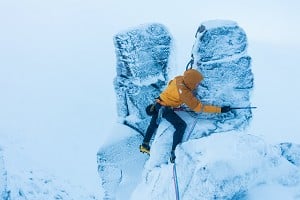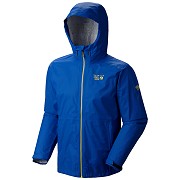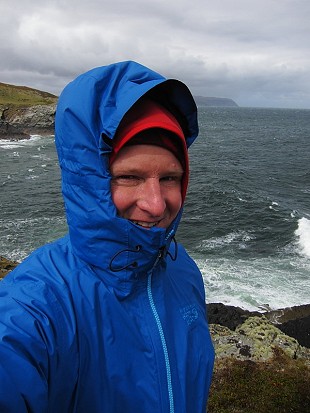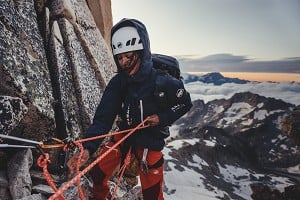
Dan Bailey gives a thumbs up to this lightweight, general-purpose wet weather shell; just don't take it out in a winter storm.
Unless you've really drawn a short straw with the weather then a full-spec mountain hard shell is likely to be overkill for most UK walking and cragging in summer - and even on decent days in spring and autumn. If you're likely to spend more time carrying a jacket than wearing it then something light and simple is obviously the thing. But in use even a lightweight waterproof shell still has to shrug off the sort of wind-blown all-pervasive rain that our hills do so well year round, while at the same time keeping sweatiness to a reasonable minimum when you're working hard. In fact there's arguably no tougher test of a breathable waterproof garment than steaming uphill on a warm, wet summer day. So while a summer waterproof can do without the whistles and bells of a bombproof winter shell, there should be no compromise on the performance of the fabric. Mountain Hardwear's Plasmic Jacket is a good example. Lighter waterproofs may be available; but the Plasmic's weight is plenty low enough, while its simple no-nonsense design retains enough of the key basics for a properly functional jacket. It's tough and well made by the standards of ultra-light gear too, and just as importantly it won't break the bank.

Features
- Fabric DryQ EVAP
- Weight 288g size L (my weight)
- Price £110
- Two hand pockets
- Watertight full-length zip
- Velcro sleeve tabs
- Drawstring at waist and hood
For more info see www.mountainhardwear.eu
I received this general purpose waterproof shell at the tail end of spring, just in time for a cold stormy trip to Scotland's north coast. Gales lashed us all week, with sudden downpours of rain and hail, and dustings of damp snow on the hills. Fortunately, with its roomy cut (in size L, on me at least) the Plasmic Jacket allowed plenty of space for under-layering in the unseasonal cold weather, while the hand pockets - the only two on the jacket - were big enough for a hat and gloves. Water beads well on Mountain Hardwear's own proprietary DryQ fabric - as you'd expect on any brand new jacket - and the Plasmic continued to keep the rain at bay even after several hours in the mist, wet and wind on Cranstackie . The chunky full-length water-resistant YKK 'Vislon Aquaguard' front zip got put through its paces too, and with the help of a little internal storm flap stood up to some pretty concerted wind-driven rain.
On a morning when our toddler couldn't stand upright outdoors I ventured to the clifftops for a blast of fresh Atlantic air. In gusts of wind that had me staggering the limitations of the lightweight hood were obvious, and its soft unstructured peak flapped like a flag. The elastic drawcords and toggles aren't sufficiently strong to keep a snug fit around the face when the wind is really determined to get in, and the whole hood inflates like a balloon. Without wishing to sound mean, it's obvious the hood has been designed with American hikers in mind - and fair weather ones at that. Of course the conditions were pushing the envelope a bit for a general purpose lightweight shell.
But while the waterproofness was in no doubt by now, that cold weather hadn't given me the best conditions to test the Plasmic's breathability. What I needed was warmth and humidity.

Then summer arrived with a vengeance, bringing some of the most sustained good weather I can remember on the hills. There was warmth aplenty, but little sign of rain. So the Plasmic Jacket languished for weeks, all but forgotten at the bottom of my rucksack on a succession of bone dry hill days, climbing trips and some overnight backpacking. At a fairly minimalist 288g (size L; my measure) you hardly notice you're carrying this jacket, and I never minded bringing it just in case. It packs down to about the size of a drink can, taking up very little room even in a small daypack.
I finally got the magic warm-and-wet combination last week in the Cairngorms. Oh joy. On a morning of low dank clag we set off optimistically for a climb on Hell's Lum. Within 20 minutes the rain set in, not heavy but insistent; that particular sort of wetness that seeps into everything. Stomping uphill with my bag of gear I was sweating even in a T-shirt, but I donned the Plasmic Jacket out of habit. Now sticking bare sweaty arms inside a waterproof shell is normally a recipe for unpleasant stickiness, but the Dry Q fabric has a special 'EVAP' lining, an ''innovative system of channels [that] disperses sweat quickly for faster evaporation, improved breathability and a drier interior feel without pit zips'. So say Mountain Hardwear, and I'd agree that it seems to banish clamminess pretty well. Working up a sweat in the rain, and still reasonably comfortable; it's not a test in lab conditions, but it's a pretty good anecdotal indication of the Plasmic's breathability.
Needless to say Hell's Lum was a write-off for climbing, so we settled for a roped scramble up Afterthought Arete. I wore the jacket all the way. As this is a non-technical garment that's not designed for climbing, it would be churlish of me to mention that the pockets are placed too low for access under a harness, or that the jacket tends to ride up when you lift your arms. What I will say though is that despite its thinness the 40-denier nylon ripstop face fabric feels surprisingly durable. This well-made jacket should require a little less of the kid glove treatment than some ultra-featherweight competitors. I won't make a regular habit of taking it out on Cairngorm granite, but neither will I worry when wearing it on the occasional scramble. With a little care the Plasmic Jacket feels like it should last well.
In conclusion: This is a well-built, reasonably priced lightweight waterproof shell for general purpose use from spring to autumn. Its low weight and small pack size make it an ideal just-in-case jacket for travelling, fair weather hillwalking or cragging - but it performs well in the wet too, and remains pretty comfortable inside even when you're working hard. The hood is not the best in high wind, and the Plasmic Jacket isn't designed for climbing in, so this isn't the shell for more challenging conditions.












Comments